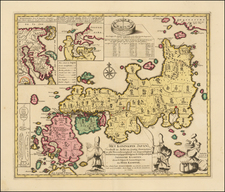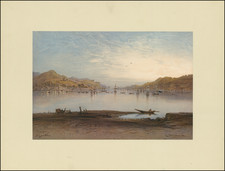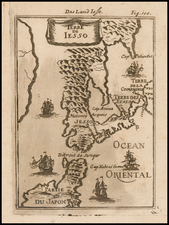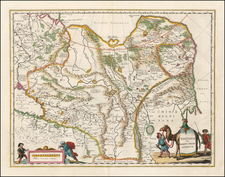This map, created by Dr. Paul Langhans in 1910, displays the railways in the border area among Russia, Japan, and China in East Asia.
The map highlights the rail lines that existed at the time, those that were under construction, and those that were planned, reflecting the state of railway development in the region at the beginning of the 20th century.
The map key, included in this image, uses different colors and patterns to distinguish between the various types of railways and territories:
- Solid orange line: Railways affected by the Japanese-Chinese agreement
- Solid blue line: Neutral railways proposed by North America
- Green dotted line: Planned Russian Amur Railway
- Solid red line: Completed railways
- Dashed red line: Railways under construction
- Dotted red line: Planned railways
- Orange and green striped area: Japanese coastal settlements in North Korea
- Yellow area: Russian territory
- Blue area: Japanese territory
- Yellow and green striped area: Chinese territory
This key provides an understanding of the complex railway network and the influence of international agreements and territorial control in the region at that time. The map is a straightforward representation of early 20th-century transportation routes and geopolitical interests in East Asia.
During this period, the region encompassing Russia, Japan, and China experienced significant historical developments, characterized by rapid industrialization, geopolitical conflicts, and shifts in power dynamics.
The late 19th century marked a period of intense modernization and Westernization in Japan following the Meiji Restoration of 1868. Japan's victory in the First Sino-Japanese War (1894-1895) over control of Korea and parts of China was a significant demonstration of its newly gained military might and industrial capacity. This victory also led to the Treaty of Shimonoseki, which ceded Taiwan and the Liaodong Peninsula to Japan, although international pressure later forced Japan to return the peninsula to China.
Russia, under Tsar Nicholas II, was expanding its influence in the East, particularly through the construction of the Trans-Siberian Railway, which was intended to connect Western Russia with its far eastern territories and the Pacific Ocean. This expansion, however, brought Russia into direct conflict with Japan, particularly over interests in Manchuria and Korea.
The Russian Empire was also dealing with internal unrest and the pressures of rapid industrialization, which culminated in the Russian Revolution of 1905. This unrest was partly caused by Russia's defeat in the Russo-Japanese War (1904-1905), a conflict that ended with the Treaty of Portsmouth, facilitated by U.S. President Theodore Roosevelt. The treaty recognized Japan's paramount interests in Korea and ceded Russia's lease of Port Arthur (now Lüshunkou) and the southern half of Sakhalin Island to Japan.
China, during this period, was grappling with the aftermath of the Qing Dynasty's losses and the concessions to foreign powers that had followed. The nation was a patchwork of spheres of influence dominated by various foreign powers, and it was experiencing internal strife that would eventually lead to the fall of the Qing Dynasty and the establishment of the Republic of China in 1912.
The culmination of these events set the stage for further developments in the 20th century, including World War I, which would see Japan joining the Allies against Germany and consolidating its hold on German possessions in China and the Pacific, while Russia's continued internal struggles would eventually lead to the Russian Revolution and the creation of the Soviet Union.









![[Clans Assigned to Defence Duty on Land and Sea in lzu, Sagami, Musashi, Kazusa, Shimofusa, and Awa Provinces] [lzu, Sagami, Musashi, Kazusa, Shimofusa, Awa kairiku okatame]](https://storage.googleapis.com/raremaps/img/small/55562.jpg)


![[Inventory of Items Presented to American Official]](https://storage.googleapis.com/raremaps/img/small/55563.jpg)

